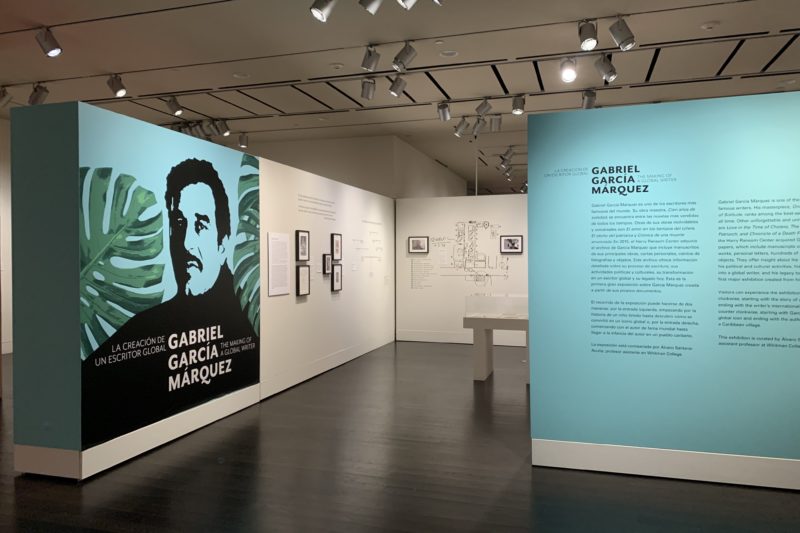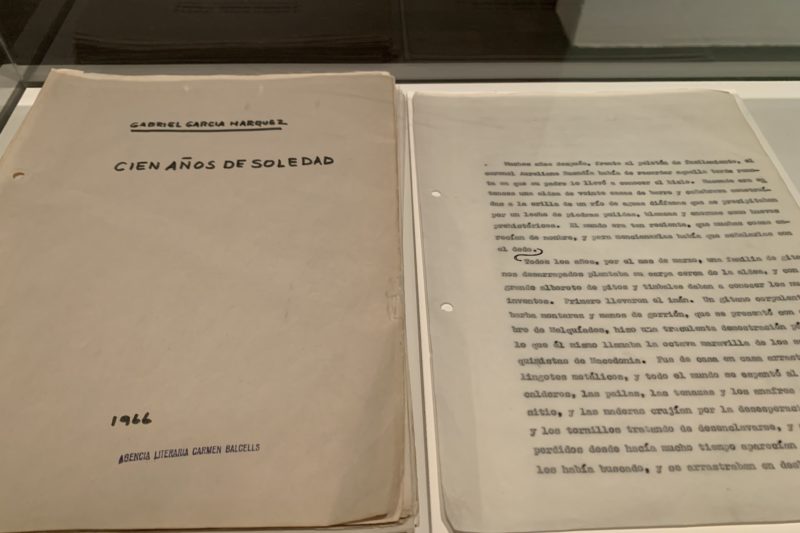Gabriel Garcia Marquez’s Magical Realism
By César Pérez
Reporting Texas

Photos by César Pérez
The morning Gabriel Garcia Marquez received news of him winning the 1982 Nobel Prize in Literature, his son Rodrigo captured the moment in a black and white. Four decades later, the photograph hangs on a wall as part of an exhibition honoring his colorful work at the University of Texas at Austin
Gabriel Garcia Marquez – or Gabo, as his fandom calls him – has an exhibition devoted to him in the Harry Ransom Center. The Colombian author, who is one of the biggest exponents of Magical Realism, transcended the barriers of Latin America. His work became renowned around the world.
The name of the exhibit – Gabriel Garcia Marquez: The Making of a Global Writer – alludes to the author’s journey to become one of the most influential writers of his time.
“[Being able to visit the exhibit is a] once in a lifetime opportunity for Gabo lovers and for literature lovers in general,” said Álvaro Santana-Acuña, the curator of the exhibit. “This exhibition is not only about one of the most important writers of the 20th century, it also tells us a lot about literature of the 20th century at large.”
The Harry Ransom Center located at the western edge of UT Austin’s campus is an internationally renowned humanities research center. According to its website, the center’s collections “provide unique insight into the creative process of some of the finest writers and artists, deepening the understanding and appreciation of literature, photography, film, art and the performing arts. “
Garcia Marquez’s collection stands alongside the works of some of America’s greatest writers including William Faulkner, Ernest Hemingway and Virginia Woolf. Other Latin American writers such as Julio Cortázar and Jorge Luis Borges can also be found there.
In the exhibit, attendees are able to view documents that have never been seen by the public before. Some of these documents include original manuscripts of the most celebrated novels by Garcia Marquez.

One Hundred Years of Solitude – a book that narrates the life of the Buendía family – is among Gabriel Garcia Marquez’s best known works.
The exhibit was reopened to the public in August 2021 after it was forced to close down in early March the previous year due to the COVID-19 pandemic. Visitors will be able to see the exhibit until January 2.
Santana-Acuña is also the author of the acclaimed book “Ascent to Glory: How One Hundred Years of Solitude Was Written and Became a Global Classic.” Santana-Acuña said he attempts to analyze and explain “the story behind the documents and the book.”
Santana-Acuña said that through his journey of researching “One Hundred Years of Solitude,” he “learned that [Gabo] was a perfectionist. He was someone who was obsessed with powerful writing.” Santana-Acuña said that Gabo began working on the idea for One Hundred Years of Solitude when he was in his early 20s, only to deliver the book 20 years later.
“If [Gabo] had to wait 10 or 20 years to deliver a story, he would do so. He was really committed to writing the best prose that he could. He was an outstanding professional,” Santana-Acuña said.
Naomi Lindstrom, a UT professor of Latin American studies, used to teach a course on Magical Realism and Gabriel Garcia Márquez. Lindstrom said that one of her favorite things about Garcia Marquez is how the author was “able to purge between journalism and creative writing,” which is unmistakable in “One Hundred Years of Solitude.“
In fact, it is that style of writing that makes Garcia Marquez one of the biggest exponents of Magical Realism. Magical realism, as described by Lindstrom, “is essentially a subcategory of fantastic literature characterized by a fusion between realistic writing and magical writing … It has a lot of details that you would find in a realistic novel, but then things happen that would never happen in a realistic novel just because they go against the laws of nature.”